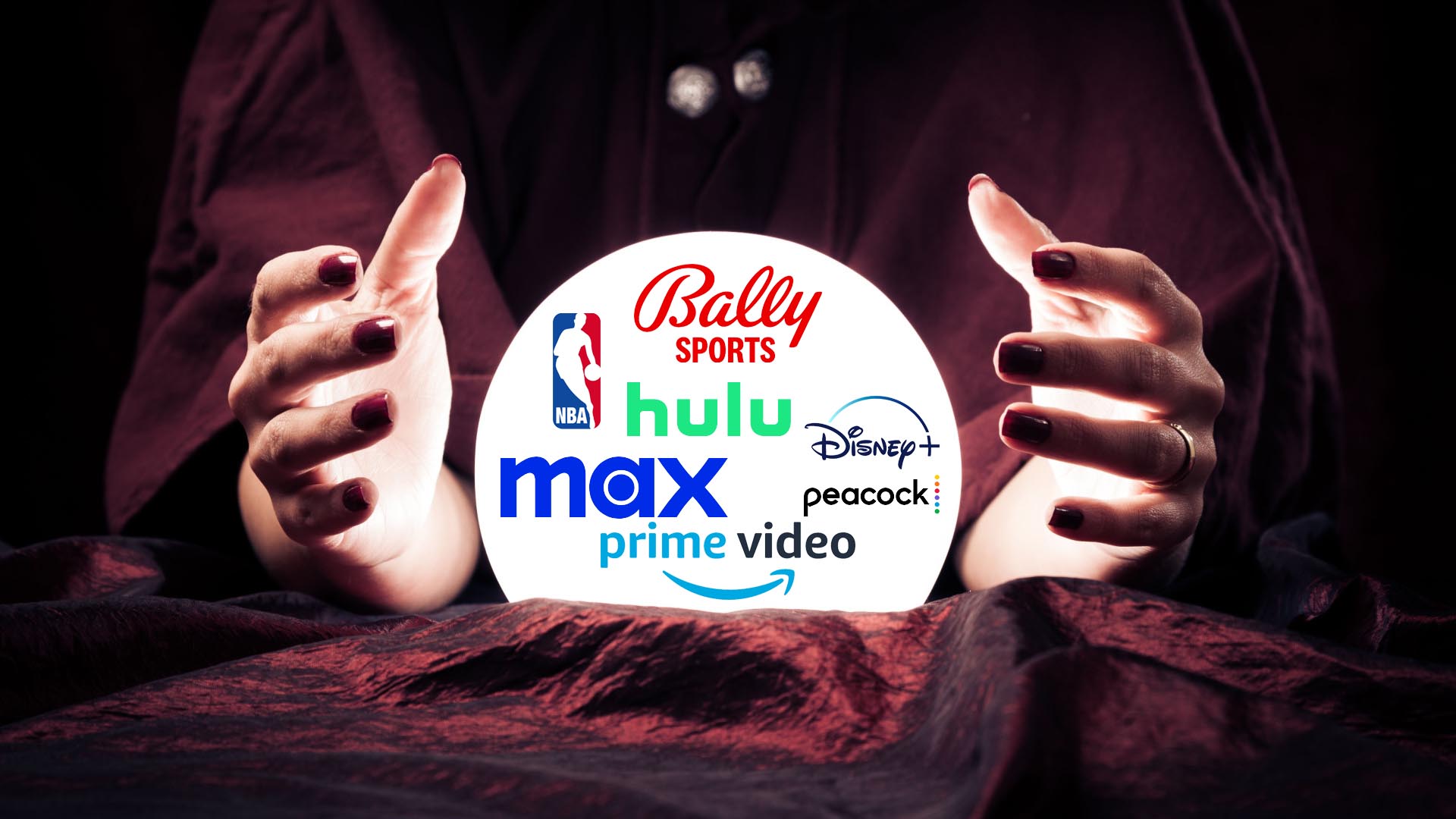
Every year, The Streamable looks deep into our crystal ball to predict the future. We correctly predicted CNN+ would crash and burn. And we called the dip in Disney+ subscriptions and the Paramount+ price hike and inclusion of Showtime.
In 2023, the tides turned in the streaming wars. While the past 4 years have seen rapid expansion of streaming services, this year saw consolidation as the prime strategy. Where will 2024 take us? Let’s find out.
1. The RSN Landscape Completely Unravels
This year saw an interesting number of defections from the RSN (regional sports network) model. Teams like the Chicago Cubs, Phoenix Suns, Utah Jazz, and Vegas Golden Knights launched their own streaming apps. In the case of the NBA teams, those games are now available free with an antenna.
Ratings for live games on an over-the-air broadcast outlet are often two to three times larger than what they pull on a regional sports network. In an era when sports are the only thing providing real-time audiences for advertisers, these teams stand to make a killing if they ditch the middleman and collect the ad dollars themselves.
Remember that 2024 is a presidential election year. Ad rates will soar as campaigns and PACs heave billions of dollars into the ecosystem. While much of that money will flood social media platforms, sports are a reliable draw for young male viewers that may be hard to reach otherwise. As Bally Sports continues flailing into bankruptcy or acquisition, it’s likely that more teams wake up to the value of their product.
In the “attention economy,” nothing is more valuable than an audience. If these sports teams can multiply their audience by leaving the RSN framework, they’d be fools not to do so.
2. Disney Kills Standalone Hulu
This month, Disney started its beta test of offering (most of) Hulu’s library inside Disney+. The final version of that team-up will arrive in March. Once that happens, we’re going to start the death watch on standalone Hulu.
Disney has been giving Hulu short shrift for years now, dumping most of its streaming budget on pricey Marvel and Star Wars shows for Disney+. Now that Disney owns Hulu outright, it’s time to make one unified streamer for the whole family.
Disney+ hit its high point at 46.6M domestic subscribers at the end of 2022. Hulu’s on-demand domestic subscribers topped out at 44M subscribers at the end of June 2023. It’s reasonable to expect the available subscriber base may be dwindling, especially as the company continues its aggressive price hikes.

It would make sense to have one primary streaming entity, with the child and teen-skewing entertainment appearing on the Disney+ side of things and the adult-skewing entertainment available on an unlockable Hulu tier. Right now, Disney+ does a terrible job serving adults, while Hulu’s children’s library is nearly nonexistent. Contrast that with Netflix — with one click, any member of the family is sure to find something that appeals to them. Disney is trying to maintain the charade that each of its services can serve a complete audience.
We do expect Hulu Live TV and ESPN+ to continue as individual services. Those have such different value propositions, it’s unnecessary to merge them. But there’s no compelling business reason to keep Disney+ and Hulu separate, especially when international Disney+ already includes adult-themed content (called Star) in nearly every other country.
3. Merger or Not, Max Drastically Raises Prices

When Warner Bros. Discovery CEO David Zaslav isn’t busy destroying creativity, he’s keeping a laser focus on his company’s cash flow. An industry built on the shoulders of dreamers means nothing to the king of penny-pinching. Since taking over the newly-merged company, Zaslav has shown a complete lack of artistic awareness.
While Zaz enjoys taking victory laps for the success of “Barbie,” he had nothing to do with that project. He did take an active role hyping the objectively terrible “The Flash,” starring an actor who has a lengthy Wikipedia section dedicated to “legal issues.” Zaslav made waves by shelving “Batgirl” and “Coyote vs. Acme.” He also hired Chris Licht, who spent 16 months eroding morale at CNN.
Zaslav reduced the Discovery networks to an unscripted content farm. But HBO’s ultimate value is a library of tightly-scripted original series. Will that continue? Will the notoriously cheap Zaslav continue to embrace the staggering costs of CGI-heavy shows like “House of the Dragon” or “The Last of Us”?
In his public statements, Zaslav continues to pound the table for more franchise content. He’s rebooting the DC movie universe with James Gunn at the helm, even as superhero films have fizzled at the box office. He’s demanding a new live-action Harry Potter TV series, even though the 20-year-old film series holds up remarkably well. Zaslav seems to think these franchises are just like his beloved “90-Day Fiancé,” where you can throw up a new season with minimal effort and reap the ratings. This is a fundamental misunderstanding of the industry. He should be speaking about empowering creators and actors to tell original stories.
It remains to be seen if David Zaslav has any ability to lead a Hollywood studio and a news organization to success. Despite widespread complaints over his content cuts on Max, Warner Bros. Discovery is now cash flow positive. And now, the rumor mill is churning that the company could merge with Paramount Global.
While Warner Bros. Discovery is surrounded by questions, we feel confident predicting that the price of Max will go up in 2024. Any merger would make that a given, but even in the absence of that, Zaslav has some very expensive movies and TV shows to pay for. If the company plans to keep its NBA rights, that bill will be enormous. The revenue from linear channels continues to drop. While Zaslav could improve his company’s financial picture by growing the audience, it’s more likely he just gouges his existing subscribers.
4. Comcast Breaks the Bank to Bring the NBA to NBC, Peacock

Speaking of the NBA, we predict Comcast will grab a chunk of the league’s broadcast rights. Remember, Comcast lost in the fight to buy 20th Century Fox. It’s sitting on a pile of cash with few remaining targets. Since Comcast owns NBC, it couldn’t grab Paramount without slicing off CBS. Paramount’s portfolio is also too similar to Comcast’s.
Peacock has enjoyed significant growth in the past year. As of September 30, the streamer had 80% more paid subscribers than the same time last year (now 28M). Peacock’s robust sports portfolio has been a key driver of that growth.
With Peacock, you can see English Premier League soccer, Big Ten basketball, figure skating, Notre Dame hockey, U.S. Soccer, cycling, Sunday Night Football, golf, horse racing, SuperMotocross, INDYCAR, WWE, rugby, and more. So what’s a good way to double down on that sports lineup with all that cash you have lying around? The NBA makes perfect sense.
What’s more, Comcast could deal a crushing blow to rivals Disney or Warner Bros. Discovery by outbidding them for rights. ESPN and TNT would lose a lot of value without basketball.
We’ve been pleasantly surprised with Peacock’s slow and steady evolution, and subscribers are proving to be more loyal as time goes on. While Peacock is lacking a breakthrough TV series or original film, those sports subscribers are likely to stick around. Adding the NBA seems like a no-brainer.
5. Prime Video’s Ad-Free Tier Flops

Starting January 29, all Prime Video subscribers will have to pay another $3 or have to sit through ads. But most of its subscribers get the service as an add-on perk of Amazon Prime. The Prime Video lineup is relatively unremarkable.
While ongoing series like “The Boys,” “Reacher,” “Invincible,” and “Gen V” have their fans, Prime Video simply doesn’t have enough original content to merit the additional fee. “The Lord of the Rings: The Rings of Power” has been a wildly expensive dud. “The Wheel of Time” isn’t making much of a dent.
Prime Video’s main value is the deep library of films and shows from other services, but that library shifts frequently. And many of the films are low-quality dreck. You’ll find titles like “Sharks of the Corn,” “Da Hip Hop Witch,” and Paris Hilton’s “The Hottie & the Nottie.”
The fact is, Prime Video has very little exclusive content that’s worth paying for. It has Thursday Night Football, but there’s no way around commercials during those games. If you’re going to sit through commercials, you may as well watch Tubi for free.
On Tubi, you can see movies like “Goodfellas,” “Rush Hour,” “North by Northwest,” “John Wick,” “Batman,” “The Departed,” “Cast Away,” “A Streetcar Named Desire,” “Kill Bill,” “2001: A Space Odyssey,” “Malcolm X,” “The Hurt Locker,” and “The Imitation Game.”
We checked, and Tubi also has “Sharks of the Corn,” “Da Hip Hop Witch,” and Paris Hilton’s “The Hottie & the Nottie.”
It’s become obvious that streaming companies are deliberately trying to push viewers to the ad-supported tier. Those plans are more lucrative than the ad-free tiers. Nearly all these companies are raising the price of the ad-free service, but Netflix smartly priced its ad-supported tier below what the ad-free tier cost. That makes it seem like a bargain without irritating its ad-free loyalists.
Amazon already has a free ad-supported streaming service (Freevee), so it’s a little weird to force paying customers to endure the same streaming experience as people who don’t pay at all. Prime Video’s slate of releases simply isn’t impressive enough to merit the ad-free subscription.
Amazon keeps its subscriber numbers a closely guarded secret, so we may never know how many or how few people will pay more for the ad-free tier. We predict that Prime Video members simply stop watching the platform and migrate to another ad-free experience like Netflix.
So that’s our annual glimpse into the crystal ball. As consumers become more choosy, streamers need to earn every dollar. Some are delivering a solid pipeline of new entertainment coupled with a valuable library. Others are failing to catch on and could be acquisition targets for the stronger companies. The competition is more fierce than ever, and the margins for error grow slimmer as shareholders grow impatient. As always, The Streamable will continue to cover the race. Be sure to sign up for our newsletter so you never miss a headline!
